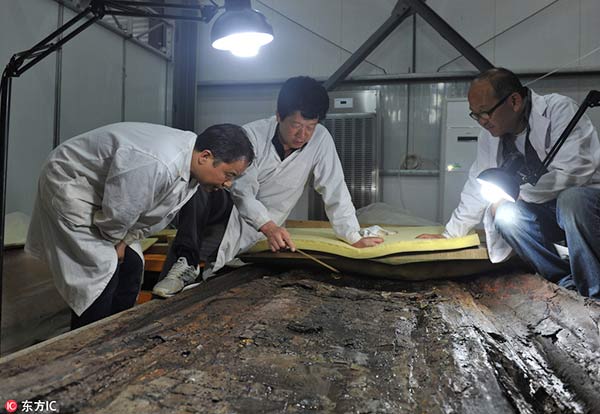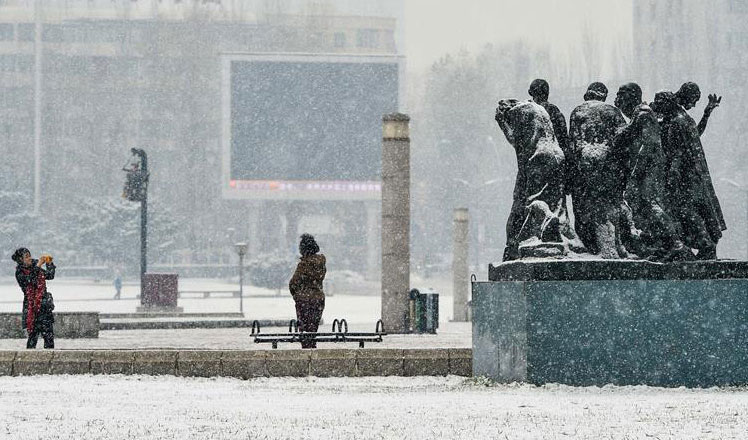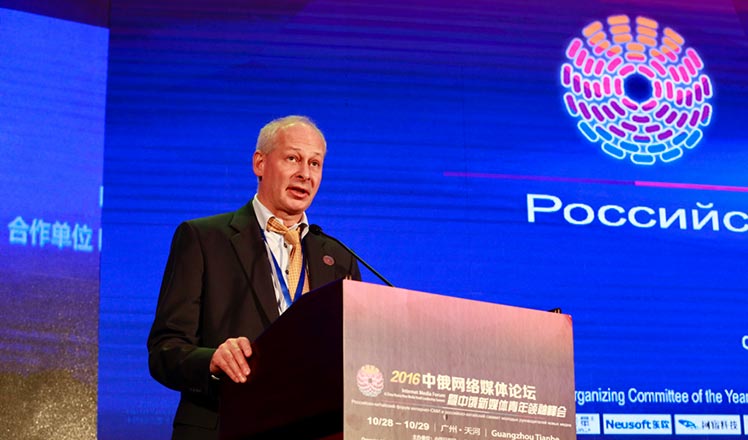Handwritings and symbols found at Emperor Liu He's tomb
Updated: 2016-11-01 11:35
By Bi Nan(chinadaily.com.cn)
|
||||||||
 |
|
Experts examine the inner coffin of Liu He's tomb in Nanchang, Jiangxi province, May 9, 2016. [Photo/IC] |
The site of Western Han Dynasty (206 BC-AD 24) Emperor Liu He's tomb recently offered new findings as the archaeological work has entered the stage of dismantling the outer coffin. Archaeologists have found numerous handwritings and symbols at the bottom of the outer coffin, according to Nanchang Evening News.
Liu He (92-59 BC), who was later given the title "Haihunhou" (the Marquis of Haihun), was the grandson of Emperor Wu, the greatest ruler of the Han Dynasty (206 BC-AD 220), one of the most prosperous periods in Chinese history.
Handwritings and symbols seen at the coffin bottom
The main coffin chamber of Liu He's tomb has been dismantled since September, and now the third level of the tomb is under extraction and dismantling. Crosstie and charcoal will be extracted later, which may reveal remains of sacrifices or other relics.
Archaeological expert Yang Jun said that they found handwritings and some symbols on the coffin and their meanings are still unknown, but archaeologists guess it marks the information of the coffin, such as the size and origin. Yang revealed that the dismantling work will last for two months. Archaeologists will number each piece of coffin wood, which will be recorded, photographed and scanned before dismantling. After that, experts will excavate or dissect the tomb bottom for two months. The dismantled coffin wood will be dehydrated, undergo insect and pollution proofing and restored to the original position after the excavation work.
- Father and son express gratitude by traveling to 200 Chinese cities
- Wife raises funds to search for missing sailor
- Two-child policy working, birthrate figures show
- China promotes transfer of farmland use right
- Hefty award offered for deciphering oracle bone characters
- China Daily brings you 'sixth plenums' in past 35 years
- EU, Canada sign landmark deals to enhance economic, political partnership
- Wife raises funds to search for missing sailor
- Clinton's edge ebbs after FBI's announcement of new email review: poll
- Asia American leaders discuss civic engagement
- World's disabled get new champion
- Clinton, Michelle Obama make first joint campaign appearance

 The World in photos: from Oct 24 to Oct 30
The World in photos: from Oct 24 to Oct 30
 Through the lens: The life of a kung fu master
Through the lens: The life of a kung fu master
 In pics: Top 10 Chinese cities in 2016
In pics: Top 10 Chinese cities in 2016
 A sprinkling of snow in China's northern part
A sprinkling of snow in China's northern part
 In pics: School uniforms get chic look
In pics: School uniforms get chic look
 China-Russia Internet Media Forum opens in Guangzhou
China-Russia Internet Media Forum opens in Guangzhou
 2016 Comedy Wildlife Photography Awards Finalists
2016 Comedy Wildlife Photography Awards Finalists
 NINED VR creates splash with virtual reality products
NINED VR creates splash with virtual reality products
Most Viewed
Editor's Picks

|

|

|

|

|

|
Today's Top News
'Zero Hunger Run' held in Rome
Trump outlines anti-terror plan, proposing extreme vetting for immigrants
Phelps puts spotlight on cupping
US launches airstrikes against IS targets in Libya's Sirte
Ministry slams US-Korean THAAD deployment
Two police officers shot at protest in Dallas
Abe's blame game reveals his policies failing to get results
Ending wildlife trafficking must be policy priority in Asia
US Weekly

|

|








